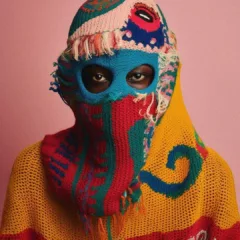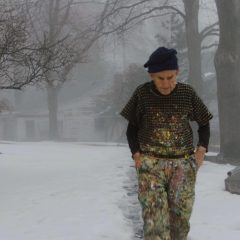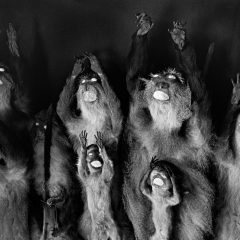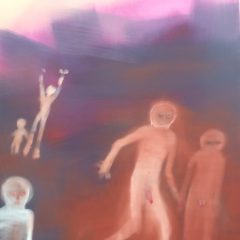In Errol Morris’s new documentary, “The B-Side: Elsa Dorfman’s Portrait Photography,” the chatty and charming elder statesman of Polaroid portraiture says that she’s lucky. Indeed, she’s had some lucky turns, being given a Hasselblad camera and access to a darkroom early on; meeting and becoming friends with poet Allen Ginsberg; being able to use, on a regular basis, one of only five Polaroid 20×24 cameras in the world. What comes across in this unfolding story of Dorfman’s life, though, whether it’s luck or not, is evidence that this hard-working, determined, open, and ambitious woman created her own fate, and when offered a golden opportunity, seized it and made something amazing.
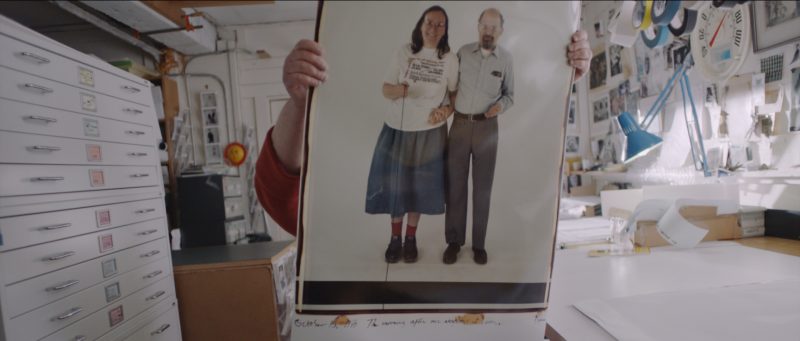
Telling stories of a life, through pictures
The film begins in the artist’s studio with Elsa talking. She tells a shaggy dog story that is triggered by a picture of her husband, Harvey, in a dark winter coat with a yellow security vest stitched on. He likes to go to the store at night to get things they need, she says. Like what? asks Morris. Oh, like a 50th box of tea, she says, with the resignation of someone who knows not to mess with her husband’s entrenched habits. But she knows what to do with her worries. Her friend stitches the vest onto the coat. And she takes a picture of Harvey in the coat, front and back views. It’s a great picture. And the story sets the tone for what follows, a carpe diem tale anchored by Dorfman’s bedrock optimism and self-confidence, in spite of comments from her mother, who constantly called her “ridiculous.”
Elsa Dorfman’s story is quiet and in her own words, mostly while seated in the narrow confines of her studio in Cambridge, MA, surrounded by flat files and photo boxes neatly stacked around her. Born in 1937, Dorfman opens boxes and drawers, seemingly at random — the chronology whiplashes back and forth through time — and the anecdotes pour forth in her hard-voweled Boston accent and with her shrug-shouldered, half-laughing manner that suggests her own amazement at her history and accomplishments. In a typical, no-nonsense statement, after revealing a series of photos of Bob Dylan and Dylan with Allen Ginsberg, which she took backstage during one of Dylan’s Rolling Thunder Revue concerts, she says, “I feel proud and incredulous but not falsely modest.”
Friendship with Allen Ginsberg
She’s got a lot to say about Ginsberg, who she met at the Grolier Book Shop in Harvard Square, and who became a dear friend. Ginsberg loved to have his picture taken. He “disarmed” himself and became unguarded in front of the camera. This comes across in the many photos of him you see in the film.
At one point you hear a clip of Ginsberg reading his poem, “America.” But he’s not reading to a live audience and the words thunder at you with power. When I listened to a reading he did of “America,” before a live audience, I picked up the humor of the powerful, strident, activist words. Listen here and you will hear the audience laughing their heads off. While humor is not mentioned as a source of the connection between Dorfman and the poet, I have to believe that it was part of the friendship’s stickiness.
One of the emotional high points in this film-reminiscence is Dorfman listening to the two voice messages she received around the time the poet died. One message, from Ginsberg himself, tells her he is in the hospital and something serious happened, will she call him? The next message is an unnamed voice telling her Allen had had a stroke and that they were “letting him go.”
Philosophy and Self Portraits
Dorfman, who took a lot of self portraits, is also a natural in front of the camera. Although, she is not “disarmed” and unguarded, and her self-portraits embody her philosophy:
“I don’t like to take a picture of people who are sad…brokenhearted. When you’re down you don’t need to walk around with a picture of it…My role is to make people feel better. It’s easy. Let’s have fun.”
History
The artist, born in 1937, graduated from Tufts in 1959 and got a job as a secretary in New York at Grove Publishers, but got out of that quickly, moving back to Boston to live with her parents and get a degree in teaching, which the self-proclaimed nice Jewish girl did. She got a job teaching in Concord, MA, but when someone introduced her to the M.I.T. Elementary Science Project (ESI), she was the happy recipient of a Hasselblad camera that changed her life and made her a photographer.

Polaroid and Dorfman’s archive
Why is this movie called “The B-Side?” That’s Dorfman’s term for one of the two Polaroid portrait shots she takes with her subjects. The subjects pick the one they want. She keeps “the b-side,” which, she thinks, in many cases is the better photo.
One of the film’s sadnesses is the end of Polaroid, the company, the process, the cameras. Dorfman calls the Polaroids magical. And their magic is no more, since the company folded and was bought by others she calls “idiots” who are not carrying on.
The future of Dorfman’s deep archive of pictures is not set. She says she’s too busy to figure out the plan. But someone should. The tip of the iceberg of the photos shown in this movie is great. And the photos deserve archiving, conserving and exhibiting.
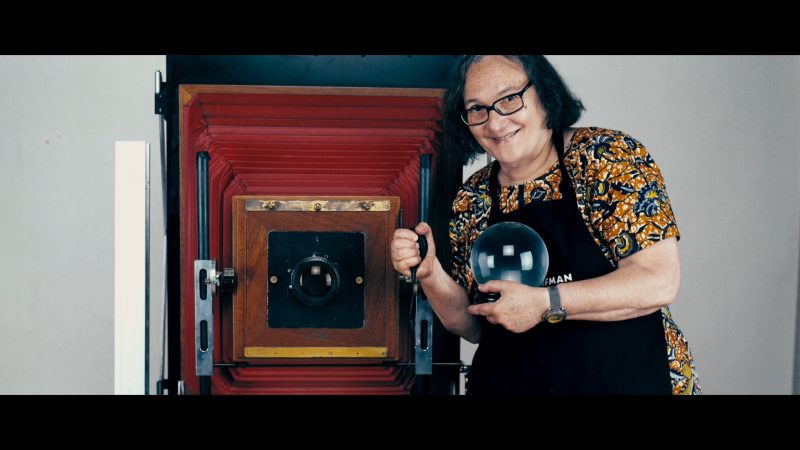
self-portrait.
I’m a big Errol Morris fan and this film, an homage to a great natural photographer, is one in which Morris’s questions and prompts to his subject stay in the background. It’s as gentle and calm as “The Fog of War” is high energy and hard-hitting with Morris’s pointed questioning and probing of Robert McNamara about the Vietnam War. I love the McNamara movie for its high-octane aggression. And I love “The B-Side” for its relaxed flow with the subject, who is a great rambling talker.
Not just for photographers and definitely not just for viewers of a certain age, “The B-Side” is a story of persistence, optimism and a take-charge spirit that is a palliative for our stress-filled times.
The B-Side, Elsa Dorfman’s Portrait Photography Opens in Philadelphia, Friday, July 21st, 2017. Ritz at the Bourse Cinema, 400 Ranstead Street, Philadelphia, PA 19106


